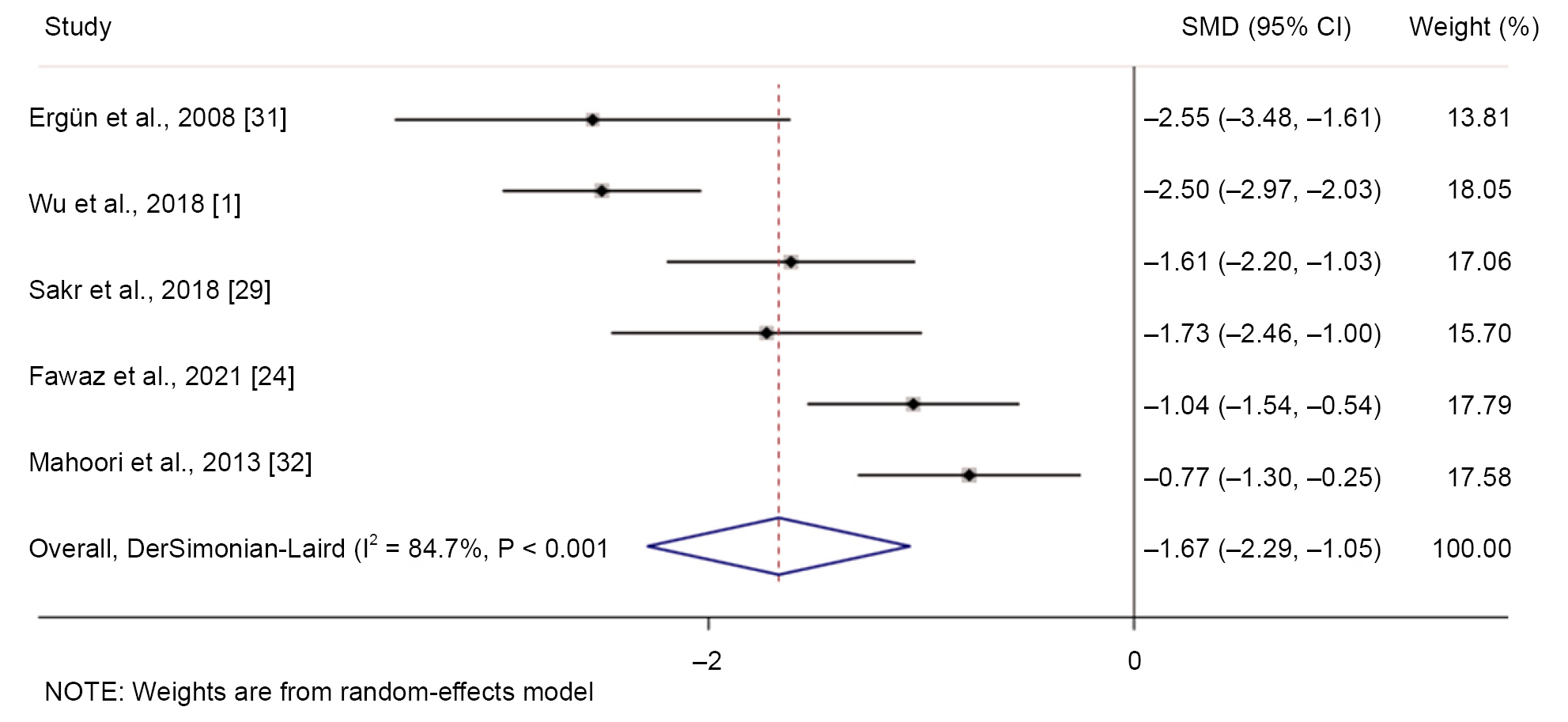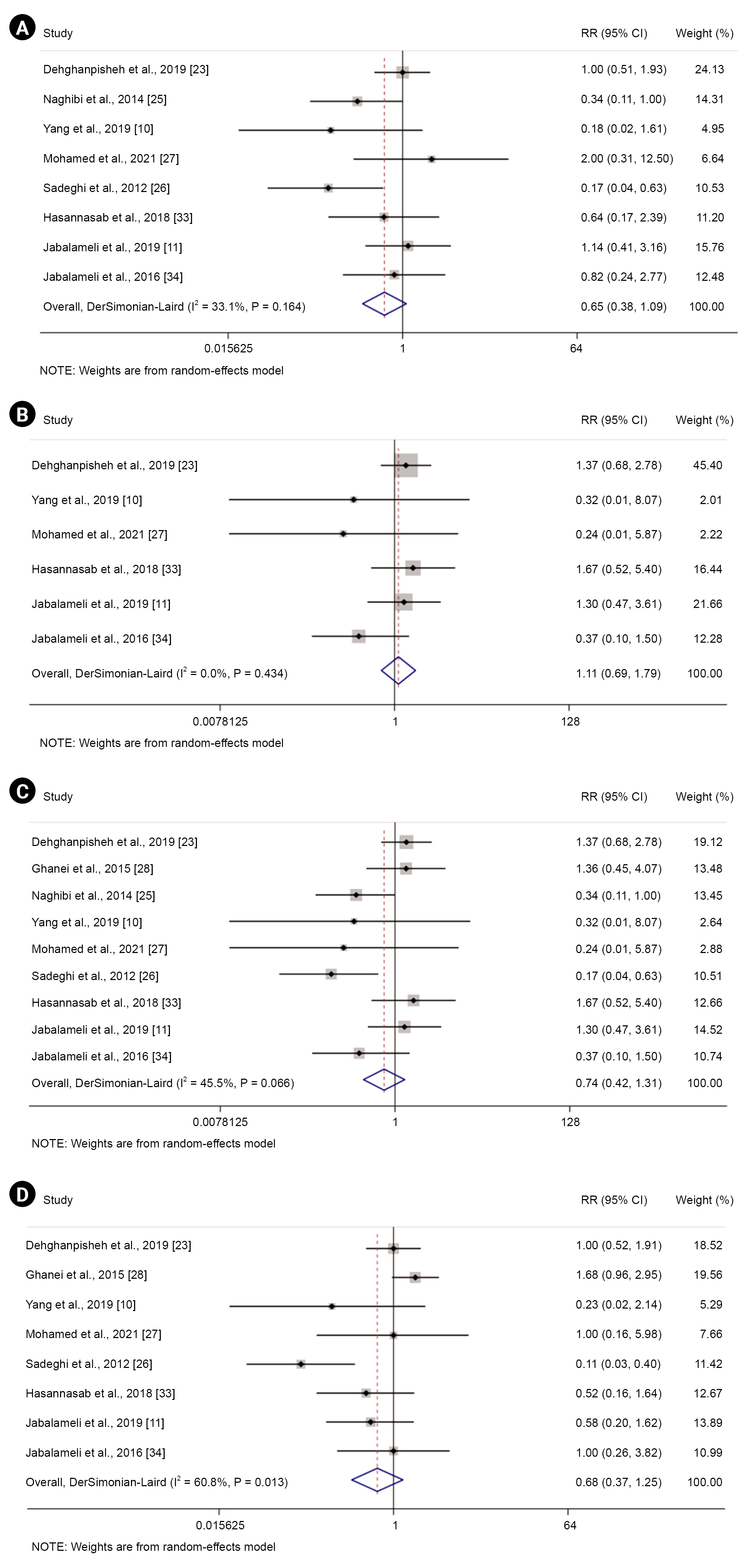 |
 |
- Search
| Anesth Pain Med > Volume 18(2); 2023 > Article |
|
Abstract
Background
Methods
Results
SUPPLEMENTARY MATERIALS
Supplementary Table 1.
Supplementary Fig. 1.
Supplementary Fig. 2.
Supplementary Fig. 3.
Notes
FUNDING
This study was supported by the Vice Chancellor for Research and Technology of Shiraz University of Medical Sciences (code: 21331). The funder had no role in the study design, analysis, decision to publish, or manuscript preparation.
DATA AVAILABILITY STATEMENT
The datasets generated and/or analyzed during the current study are available from the corresponding author upon reasonable request.
AUTHOR CONTRIBUTIONS
Conceptualization: Reza Barati-Boldaji, Sara Shojaei-Zarghani, Manoosh Mehrabi, Afshin Amini, Ali Reza Safarpour. Data curation: Reza Barati-Boldaji, Ali Reza Safarpour. Formal analysis: Reza Barati-Boldaji, Ali Reza Safarpour. Funding acquisition: Ali Reza Safarpour. Methodology: Reza Barati-Boldaji, Sara Shojaei-Zarghani, Manoosh Mehrabi, Afshin Amini, Ali Reza Safarpour. Project administration: Ali Reza Safarpour. Visualization: Ali Reza Safarpour. Writing - original draft: Reza Barati-Boldaji, Sara Shojaei-Zarghani. Writing - review & editing: Manoosh Mehrabi, Afshin Amini, Ali Reza Safarpour. Investigation: Ali Reza Safarpour. Resources: Ali Reza Safarpour. Software: Ali Reza Safarpour. Supervision: Ali Reza Safarpour. Validation: Ali Reza Safarpour.
ACKNOWLEDGMENTS
Fig. 2.

Fig. 3.

Table 1.
| Study | Location | Sex | Age (yr) | Study population | Number of participants (control group, intervention group) | Time of pain assessment following aminophylline/theophylline (h) | Dosage of aminophylline/theophylline | Control group | Outcome | Risk of bias |
|---|---|---|---|---|---|---|---|---|---|---|
| Ergün et al., 2008 [31] | Turkey | M/F | 31.88 | Patients who had undergone lumbar puncture for diagnosis or epidural anesthesia and subsequently developed PDPH | 16, 17 | 4 | Theophylline, 200 mg, iv | 5% dextrose | VAS | High |
| Wu et al., 2018 [1] | China | M/F | 36.5 | 64, 62 | 0.5 | Aminophylline, 50 mg, iv once daily for 2 consecutive days | Normal saline | VAS | Low | |
| Patients with PDPH | 1 | 2 | ||||||||
| 8 | ||||||||||
| 12 | ||||||||||
| Sakr et al., 2018 [29] | Egypt | M/F | 26.23 | 30, 30 | 1 | Paracetamol | NRS | Unclear | ||
| Patient with lower extremity and lower abdominal surgery under spinal anesthesia | 7 | Theophylline, 250 mg orally/8 hours + Paracetamol 500 mg/8 hours orally | ||||||||
| 13 | ||||||||||
| 19 | ||||||||||
| Sen et al., 2014 [30] | India | M/F | 30 | Patients under spinal anesthesia | 20, 20 | Theophylline, 400 mg orally | Conservative treatment* | VAS | High | |
| 8 | ||||||||||
| 16 | ||||||||||
| 24 | ||||||||||
| Fawaz et al., 2021 [24] | Egypt | M/F | 32.77 | Patients with PDPH | 35, 35 | Aminophylline, 250 mg, iv | 1 g paracetamol, iv | VAS | Low | |
| 2 | ||||||||||
| 6 | ||||||||||
| 12 | ||||||||||
| Mahoori et al., 2013 [32] | Iran | M/F | 40.06 | Patients with PDPH | 30, 30 | 2 | Theophylline, tablet 250 mg three times per day | Acetaminophen 500 mg three times per day | VAS | High |
| 6 | ||||||||||
| 12 |
Table 2.
| Study | Location | Sex | Age (yr) | Study population | Number of participants (control group, intervention group) | Time of pain assessment following aminophylline (h) | Dosage of aminophylline | Control group | Outcome | Risk of bias |
|---|---|---|---|---|---|---|---|---|---|---|
| Dehghanpisheh et al., 2019 [23] | Iran | F | 30 | Women undergoing cesarean surgery under spinal anesthesia | 100, 100 | 1 mg/kg iv | Normal saline | NRS | Low | |
| Total | ||||||||||
| 24 | ||||||||||
| 48 | ||||||||||
| 72 | ||||||||||
| Ghanei et al., 2015 [28] | Iran | F | 30 | Women undergoing cesarean surgery under spinal anesthesia | 100, 100 | 2 mg/kg iv combined with conventional therapy | Conventional therapy* | VAS | Low | |
| 6 to 12 | ||||||||||
| 12 to 24 | ||||||||||
| ⏵24 | ||||||||||
| Naghibi et al., 2014 [25] | Iran | M/F | 45.7 | Patients undergoing lower extremity surgery | 35, 34 | 6 to 48 | 1.5 mg/kg iv | Normal saline | VAS | Low |
| Yang et al., 2019 [10] | China | F | 27.2 | Women undergoing cesarean surgery under combined spinal epidural anesthesia | 58, 59 | 250 mg of aminophylline oral | Normal saline | NR | Low | |
| 24 | ||||||||||
| 48 | ||||||||||
| 72 | ||||||||||
| Mohamed et al., 2021 [27] | Egypt | F | 25 | Women undergoing cesarean surgery under spinal anesthesia | 52, 52 | 100 μg/kg/min) diluted in 50 ml normal saline (0.9%) infusion for 30 minutes | Normal saline | VAS | Unclear | |
| 24 | ||||||||||
| 48 | ||||||||||
| 72 | ||||||||||
| Sadeghi et al., 2012 [26] | Iran | F | 26.11 | Women undergoing cesarean surgery under spinal anesthesia | 60, 60 | 1 mg/kg iv | NR | VAS | Unclear | |
| 24 | ||||||||||
| 48 | ||||||||||
| Hasannasab et al., 2018 [33] | Iran | F | 28.3 | Women undergoing cesarean surgery under spinal anesthesia | 70, 70 | 1 mg/kg iv | Normal saline | VAS | Low | |
| 8 | ||||||||||
| 24 | ||||||||||
| 48 | ||||||||||
| 72 | ||||||||||
| Jabalameli et al., 2019 [11] | Iran | M/F | 35 | Patients undergoing lower extremity surgery | 30, 30 | 1.5 mg/kg iv | Normal saline | VAS | Low | |
| 6 | ||||||||||
| 12 | ||||||||||
| 18 | ||||||||||
| 24 | ||||||||||
| 48 | ||||||||||
| 72 | ||||||||||
| Jabalameli et al., 2016 [34] | Iran | M/F | 30.5 | Patients undergoing lower extremity surgery | 34, 34 | 1.5 mg/kg iv | Normal saline | VAS | Unclear | |
| 6 | ||||||||||
| 12 | ||||||||||
| 18 | ||||||||||
| 24 | ||||||||||
| 48 | ||||||||||
| 72 |
Table 3.
| Variables | Number of studies | SMD | 95% CI | P value within subgroup | I² (%) | P value for heterogeneity | P value for subgroup difference |
|---|---|---|---|---|---|---|---|
| Age (yr) | |||||||
| < 32 | 3 | -1.87 | -2.37 to -1.36 | < 0.001 | 30.3 | 0.230 | 0.480 |
| ≥ 32 | 3 | -1.44 | -2.52 to -0.36 | 0.009 | 92.9 | < 0.001 | |
| Type of control group | |||||||
| Placebo | 2 | -2.51 | -2.93 to -2.09 | < 0.001 | 0.0 | 0.940 | < 0.001 |
| Conventional therapy* | 4 | -1.25 | -1.68 to -0.81 | < 0.001 | 56.2 | 0.070 | |
| Time of VAS score measurement | |||||||
| ≤ 12 h | 3 | -1.36 | -2.19 to -0.53 | 0.001 | 81.4 | 0.005 | 0.230 |
| > 12 wk | 3 | -1.98 | -2.59 to -1.37 | < 0.001 | 69.1 | 0.030 | |
| Route of aminophylline administration | |||||||
| Intravenous | 3 | -2 | -3.07 to -0.92 | < 0.001 | 89.8 | < 0.001 | 0.290 |
| Oral | 3 | -1.34 | -1.96 to -0.72 | < 0.001 | 68.0 | 0.040 | |
| Type of intervention | |||||||
| Theophylline | 4 | -1.59 | -2.28 to -0.91 | < 0.001 | 76.0 | 0.006 | 0.820 |
| Aminophylline | 2 | -1.77 | -3.22 to -0.33 | 0.010 | 94.0 | < 0.001 | |
| Quality of studies | |||||||
| Low | 3 | -1.63 | -2.64 to -0.62 | 0.002 | 83.3 | 0.002 | 0.480 |
| Moderate/high | 3 | -1.72 | -2.61 to -0.83 | < 0.001 | 88.9 | < 0.001 |
Table 4.
REFERENCES
- TOOLS
-
METRICS

-
- 5 Crossref
- 2,462 View
- 107 Download
- Related articles in Anesth Pain Med
- ARTICLE & TOPICS
-
- Topics
-
- Neuroscience in anesthesiology and critical care
- Anesthetic Pharmacology
- Obstetric Anesthesia
- Pediatric Anesthesia
- Cardiothoracic and Vascular Anesthesia
- Transplantation Anesthesia
- Spinal Pain
- Regional Anesthesia
- Neuromuscular Physiology and Pharmacology
- Airway Management
- Geriatric anesthesia and Pain
- Others








